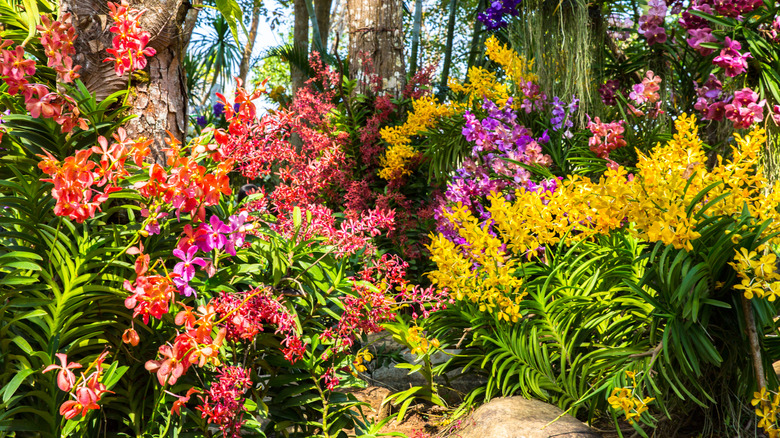The Stunning Tropical Flower That Blooms Well Into The Fall
While some of the brightest blooms fade all too soon, the same can't be said for pentas (Pentas lanceolata). Going by the common name Egyptian star flower or Egyptian starcluster, this plant is native to the tropics of East Africa and the Arabian peninsula and has prolific clusters of dazzling star-shaped, five-petaled flowers all the way through the summer until the frosts come. It's winter hardy in USDA Zones 10 through 11, where it can be grown as an evergreen perennial – making it one of the best flowers for the Florida panhandle and other regions with similar weather. Outside of these warm areas, it can be grown as an annual, but it also adapts well to life in a container and can be easily moved indoors when cold weather threatens.
There are a number of pentas cultivars available in colors ranging from pink or red to purple, blue, or white. You can expect a lot of pollinator traffic when they are in bloom; hummingbirds, bees, butterflies, and more are all drawn to the blossoms . The red varieties are particularly popular among hummingbirds thanks to their color and tubular shape. Pentas is well suited to a wide variety of applications — try using mass plantings as colorful borders and hedges or a single plant as part of a container garden. It can even be a houseplant.
How to grow and care for pentas
Sun-loving pentas will deliver its best blooms when planted in an area that gets plenty of direct sunlight, though it can also tolerate partial shade. It favors well-drained, slightly acidic soil, but it isn't terribly fussy. To care for a pentas plant, you should water regularly, but be sure to let the soil dry out a bit between waterings — thankfully, pentas has decent drought tolerance. You can apply a balanced fertilizer every six weeks to give it a boost. If you have to trim pentas plants down in hedge or border applications, keep in mind that the flowers grow on new growth. So you might see somewhat fewer flowers on recently pruned areas.
You can start a new pentas plant either from cuttings or from seed, though seed is a slower prospect, taking 14 weeks or so to produce flowers. You can start seeds indoors eight to 10 weeks before the last frost is expected, or you can try starting softwood cuttings in either water or soil. If you plan on bringing container-planted pentas indoors for the winter, make sure to place them in an area that is bright and somewhat cool while reducing the frequency of watering.

